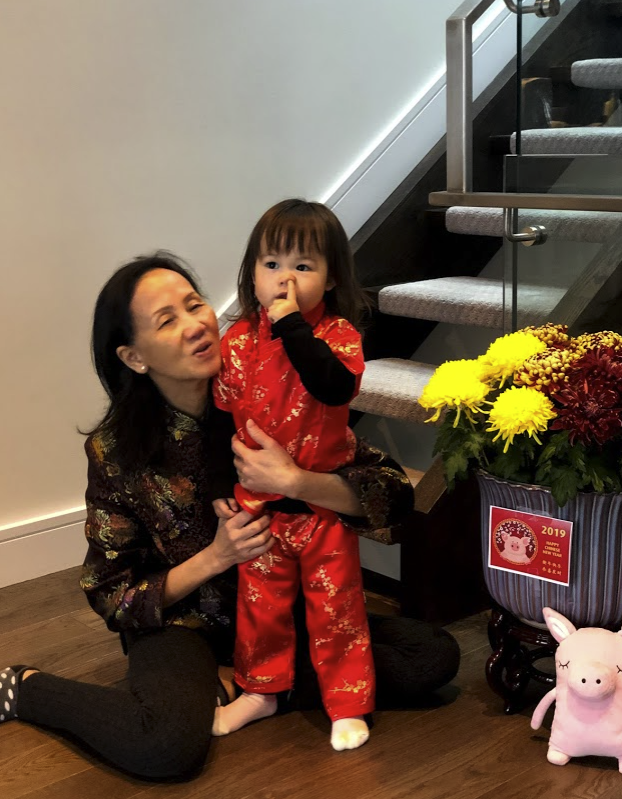Many people are curious to hear that I live in both a multi-generational home and a bi-racial home as well. To elaborate, I’m Chinese and my husband is not. My mother also lives with us during the week to help us out (cooking, cleaning, child-rearing) and then goes back home to Hamilton where she and my dad live. She jokes that her retirement life consists of her always “taking breaks.” During the week she’s at our house which gives her a nice “break” from my dad, and then when she returns home from Friday to Sunday she is happy to “take a break from us.”
When my daughter was born (four years ago), I made a strong concerted effort to exclusively speak Cantonese to her. I can speak Cantonese conversationally but if I were to go to Chinatown to converse with the locals, let’s just say they would laugh me right out of the street. That’s why it was incredibly advantageous to have my mom around during mat leave — both of us would just speak Cantonese exclusively to each other and to my daughter. My Cantonese truly flourished at the time, and so did my husband’s!

Kensi’s first words were in Chinese (ahp-ahp = duck!). As she was picking up more and more words, she was also able to distinguish and translate from Chinese to Eng (and vice versa). By the time she was two years old, she was conversing fairly fluently in both Chinese and English and would act as a little translator for my husband whenever he couldn’t understand the things we were saying.
Then she started going to daycare… and it was GAME OVER.

All of a sudden she stopped responding back in Chinese and responding exclusively in English. When I would prompt her to respond back in Chinese she grew resistant. Ever try to prod or push a toddler to do something? Good luck! She only became more weary and resistant knowing that I wanted her to respond back in Chinese. Suddenly I was becoming panicked, all of the work I had been doing for the past year seemed like it was slipping away!
I then did what I often do at home when I feel like I’m losing control. I panicked, started running around yelling like a crazy person trying to place blame on my mom for not enforcing enough Chinese and my husband for not speaking enough Chinese. I was being irrational and totally out of control. I had to take a serious chill pill.
This is the dilemma that many multilingual and multicultural families are faced with and was the exact same dilemma my parents felt when I entered an English-speaking streamed school when I was a child. The fear that your mother language and cultural identity diminishes is a huge and legitimate concern as children are deeply immersed in an English-speaking Western culture.

So where do we go from here?
After my irrational episode of blaming everyone under the sun, I took a deep breath and meditated. I dug deep into the trenches of my childhood memories and remembered how annoying and antagonizing it felt for my parents to constantly try to force Chinese on me. Didn’t they know everyone around me spoke English?!
I also remember always feeling weird and different growing up that my lunches weren’t the same, that our holidays didn’t seem the same, and that what I saw on TV shows and books in front of me didn’t seem reflective of what my life and family looked like.
Then I realized what I had to do, as much as it pained me to do so. I had to stop forcing Kensi to respond back in Chinese and just let it go.

Nobody likes to be strong armed and forced into something that doesn’t feel natural or normal to them. So instead, I pivoted and began to become incredibly intentional about the books, TV shows, media and language we consumed in the home. I focused on the feelings I wanted to elicit from Kensi instead of the outcome of just speaking in Chinese.
These feelings included:
- Being proud to speak another language such as Chinese
- Being proud to celebrate distinct and unique holidays and traditions
- Recognizing diversity and how everyone’s backgrounds and families are different
Once I lasered in on the feelings I wanted to cultivate, then the actions for nurturing these feelings followed suit:
- Continuing to speak Chinese exclusively at home (as much as possible)
- Collecting and reading more diverse books that reflect our family such as Amy Wu and the Perfect Bao and My Day with Gong Gong
- Celebrating cultural holidays such as Chinese New Year and Mid Autumn Festival and including EVERYONE in the celebration. This means serving moon cake for guests when they visit our home during the fall or inviting everyone under the sun to our Chinese New Year brunch that we typically host. By the way the CNY brunch is the “hottest” event on my block… as described by my teenage neighbours.
- Watching shows that provide more diverse ethnic representation. Recently my husband found this really cool show on Crave called Happily Ever After: Fairy Tales For Every Child which apparently was a show created in the mid ’90s. There are three seasons and each episode features a fairy tale/classic children’s story but reimagined with characters from different ethnic backgrounds. This morning my daughter watched Little Red Riding Hood featuring a little Asian girl who was bringing dumplings to her “Poh Poh” and running into a wolf. Very cute!

Happy to report that since I pivoted to focusing on cultivating the feelings versus the outcome of speaking Chinese, Kensi has really embraced her Chinese heritage. Sure she doesn’t respond in Chinese as much as I would like, but she understands it perfectly. She also loves to randomly ask, “What’s this in Chinese?” and point to random objects, animals and items that we encounter. She also seems to really like Mooncake and whenever we watch shows or read books that feature a little Asian girl, she loves to exclaim, “That person looks like me!”
This post originally appeared on itshung.com and has been republished with permission from the author.
Katy lives in Toronto with her husband, daughter and beloved dog, Frankly. She works in tech and in her spare time she loves hanging out with family, friends and eating meatball subs… in that order. You can read about her musings on parenthood, pop culture, and, of course, food, on her blog itshung.com.
Like this post? Follow The RepresentASIAN Project on Instagram, TikTok and YouTube to keep updated on the latest content.








